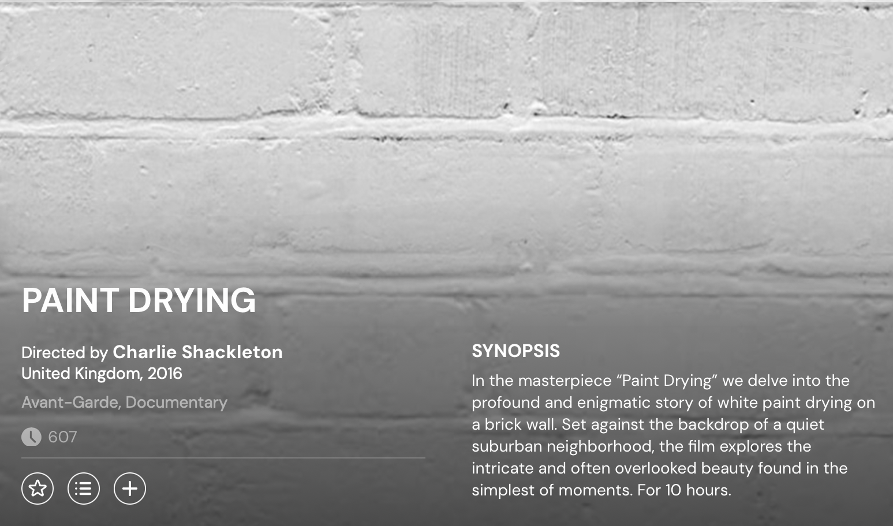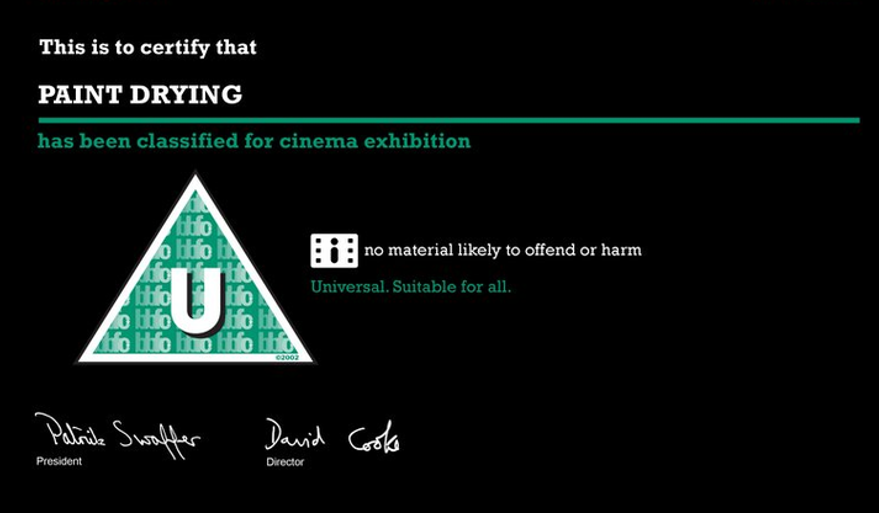I’ll relay the events in the same order I learned them.
While doom scrolling through TikTok I came across a video that told me you can log a ten hour video of paint drying on Letterboxd. This is not unusual for the social cataloguing app. While Letterboxd was designed for people to share and review movies, there’s plenty of entries that most people wouldn’t consider films (including but not limited to TV shows, anime and Bill Wurtz’s history of the entire world, I guess). Even so, ten hours of paint drying was strange enough to catch my attention.
There’s nowhere online you can watch Charlie Shackleton’s 2016 film Paint Drying1. It has only been shown once at the Queensland Art Gallery and Gallery of Modern Art in Brisbane. Despite this, it has 7.8K logs and 10K reviews on Letterboxd. A number of these reviews are what you’d expect from this page. Some decry the ridiculousness of the film’s existence, others jokingly praise it as a masterpiece, but a large number of these reviews hold a different purpose.
It all started on July 26th 2020. Letterboxd user M logs Paint Drying with a review:
This was the first review of its kind on the page, no one yet knew what it would spark. Two and a half weeks later Letterboxd user Prad Bitt, feeling demoralised by the lack of engagement they get, wrote a similarly confessional review. Eleven days after that another user, Felipe, left a review that began with “I’m going to use this space for some [updates]” before explaining they won’t be as active because their house burnt down.
The trend continued to grow. Some users used the page to vent, like user MarMar in February 2021, who wrote about their frustration with the app. Others used it to log information that you typically cannot log on Letterboxd, like TV episodes. Some used it as a way to post statuses to their followers, sharing their achievements or expressing gratitude for support. With a space given to say something, we once again see everyone has something to say.
Scrolling through the reviews, you are flooded with thousands of little out of context pieces of people’s lives. Users with more than one entry leave a ledger of their thoughts and life, giving updates on their previous posts. Reading through the reviews chronologically gives a record of the past few years. You can see users react to major world news, such as the January 6th Insurrection or the recent attempted assassination of Donald Trump. Creators big and small have gotten involved. George Carmi, the host of the ReelTok Podcast, used it to reveal he had been battling cancer. User NathanB2006 let everyone know it was his eighteenth birthday.





Describing this, it doesn’t sound too different from your Twitter feed, but Paint Drying’s Letterboxd page has proven to be a safe space. I spoke to several contributors to the feed to find out more about what drew people to this trend. Everyone I spoke to said their attention was drawn to it after someone they followed posted a non-review on the Paint Drying Letterboxd page. When talking about their experiences on the page, they were overwhelmingly positive. Some accounted one off positive interactions with strangers, other talked about friendships that had formed from the page. “It’s such a testament to how much of community space Letterboxd is,” one commenter writes. Another describes it as “a refreshing look at what the internet could be.”
I don’t believe it’s a coincidence that this trend began during the Pandemic. Many users mentioned the Pandemic when talking about their involvement with the trend.“I’d had the app for three years and I guess it took the global pandemic and the loneliness that came with it for me to actually comment on people’s stuff and gather a bit of community” Letterboxd user Matt told me. Another anonymous user talked about what a great way it was to reach out to people with similar interests. When people needed connection more than ever, they forged it in the most unlikely of places.
The user who began it all, M, has since abandoned their account. The review that started the trend has two comments, one of which was made this year. User RangeReaper replied “I know this account is abandoned, but I really hope things are going better for you, M.” There’s no way of knowing where M is now, there’s no contact details on their old account. Yet a stranger still reached through time to give kind words to someone who was feeling down four years ago. It’s such a beautifully human sentiment in such an unexpected place.
To think all this support and human connection came out of a random video of paint drying. Did the person who filmed 10 hours of paint drying know it would cause so much conversation?
Well, sort of.
Charlie Shackleton is a British multimedia artist and filmmaker. Shackleton describes his gripe with censorship beginning when he discovered six seconds had been cut from Fight Club (1999) by The British Board of Film Classification (BBFC) to “reduce the sense of sadistic pleasure in inflicting violence.” His issues with the BBFC, which are laid out in his 2015 manifesto “Why I’m Making British Film Censors Watch Paint Dry”, only grew with him. He criticised their lax definition of ‘risk of harm’ when it comes to what gets censored and their zealous attitude towards banning films that don’t match their tastes. This is a particularly pressing issue considering films can be banned outright from the UK by the BBFC, and it is illegal to distribute your film without their certification. Basically, what films can make money in the UK is decided based on subjective judgements by the BBFC. This doesn’t stop distribution, it just strips creatives of the ability to make money from their work.
The BBFC also act as gatekeepers for independent filmmakers. When Shackleton began raising money for Paint Drying, it cost £7.09 per minute of runtime to get your film rated by the BBFC, on top of an additional standard charge of £101.50. This is a huge obstacle for low budget filmmakers, which dissuades many from making their films. These reasons inspired Shackleton to crowd fund a 10 hour protest piece to submit for rating to the BBFC.
Protest art can be controversial. Complaints can be made that it is performative or ineffective. These complaints have been made about Paint Drying on its own Letterboxd page. One review written on 18 April 2021 reads:
“…The movie was made by Charlie Lyne2 as a protest to the expenses incurred by [independent filmmakers] imposed by British Board of Film Classification. It cost around £1000 to rate a film and a refusal resulted in the movie being banned.
It didn't really do anything other than cause people to talk about it.”
Before hearing about Paint Drying (2016) I didn’t know about the cost of getting certified by the BBFC. I never considered that as an obstacle for underprivileged filmmakers. While some may complain that Paint Drying is nothing more than a conversation starter, I feel that is its greatest strength. An act of protest so succinctly petty that it can spread by being passed around as a fun fact. It is the perfect issue to be tackled by awareness. The general public have too much to consider day to day without thinking about how the art they are consuming is filtered. Not unless there’s a fun story to bring that thought to the forefront. As Shackleton put it in an interview with Mashable: "In truth, those 10 hours are really just the catalyst for everything else: people reading about and joining the protest; people questioning (or defending) the role of the BBFC; this conversation we're having right now."
Shackleton has since discovered what is going on with his film’s Letterboxd page. In an interview with IndieWire he described feeling overwhelmed by the scale of it. “It’s such an unlikely second act for this project… I never really imagined it would have an afterlife.” It could be assumed that the second life of Shackleton’s protest would help further his message. That’s how I found out about it, that’s how any of this even came to my attention. But to my surprise, many of the Letterboxd users I talked to didn’t know anything about Shackleton or his protests. The Letterboxd trend around Paint Drying came without the prior knowledge of Shackleton’s mission.
The BBFC’s policy of censorship has changed since Shackleton’s protest. Theatrical releases are priced in a tier system by the number of theatres they are released in rather than a per minute fee. While still imperfect, this reduces the height of the barrier to release for a lot of independently produced films. Without an issue to bring awareness to, Paint Drying’s afterlife on Letterboxd has given it a chance to foster community. A strange unconnected second function for the art piece.
I can’t stop thinking about Paint Drying. I can’t stop thinking about what a perfectly simply protest of censorship it was. I can’t stop thinking of the film’s metamorphosis into a safe space for like minded people to support each other. I can’t stop thinking how these two stories come from the same piece yet they have little to do with one another. You can find a surprising through line in the two separate functions of this one film. Paint Drying started off as a protest for censorship, since then it has birthed a home for the unfiltered thoughts of thousands. I don’t know what that says, I just know I can’t stop thinking about it.
This would be about as good of use of my time as doom scrolling on TikTok is.
Charlie Shackleton used his father’s surname Lyne until 2019







